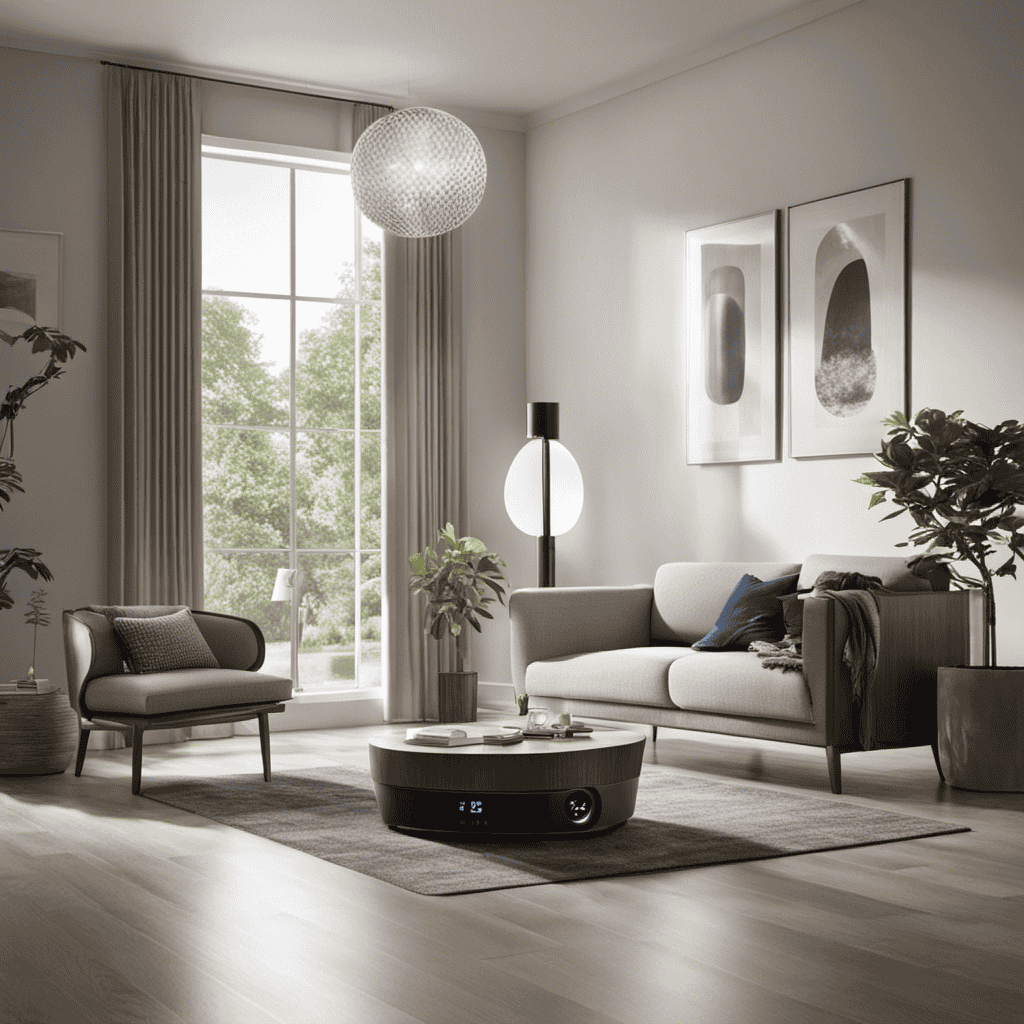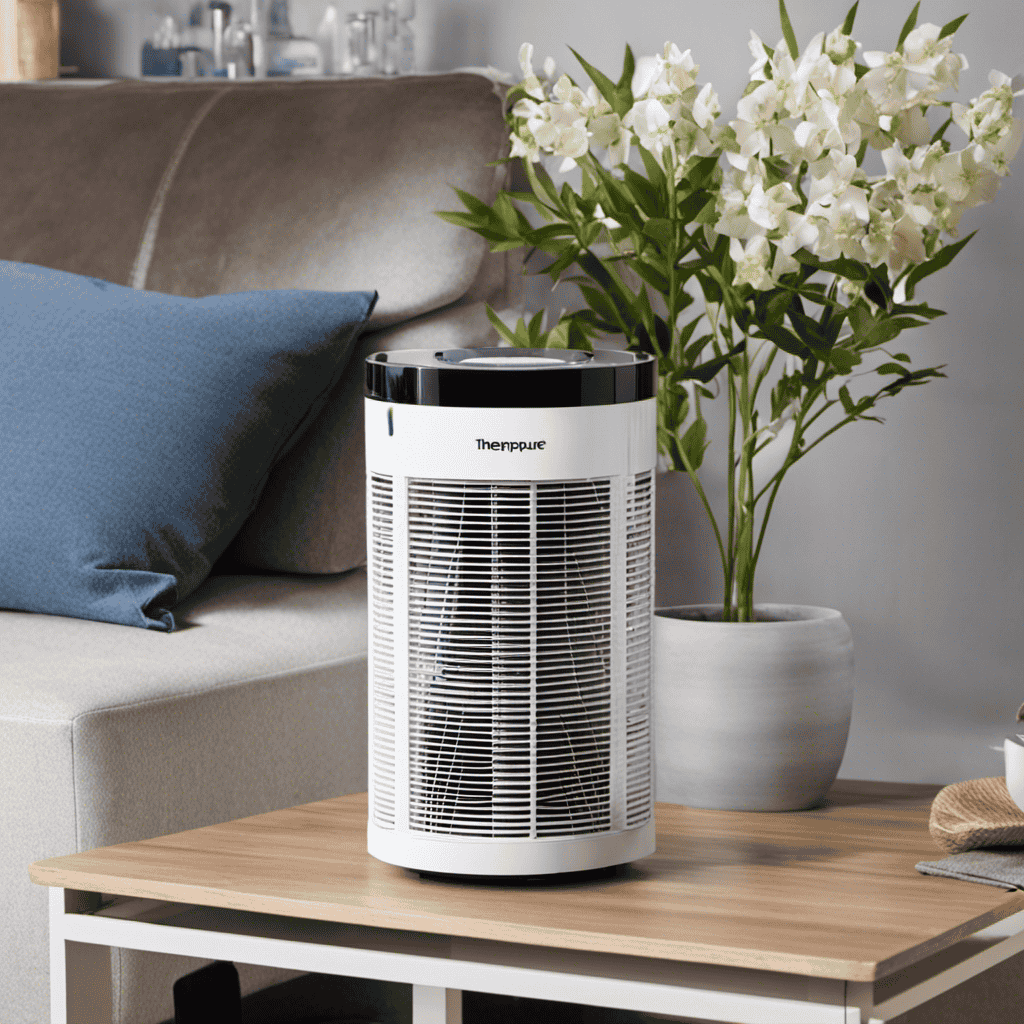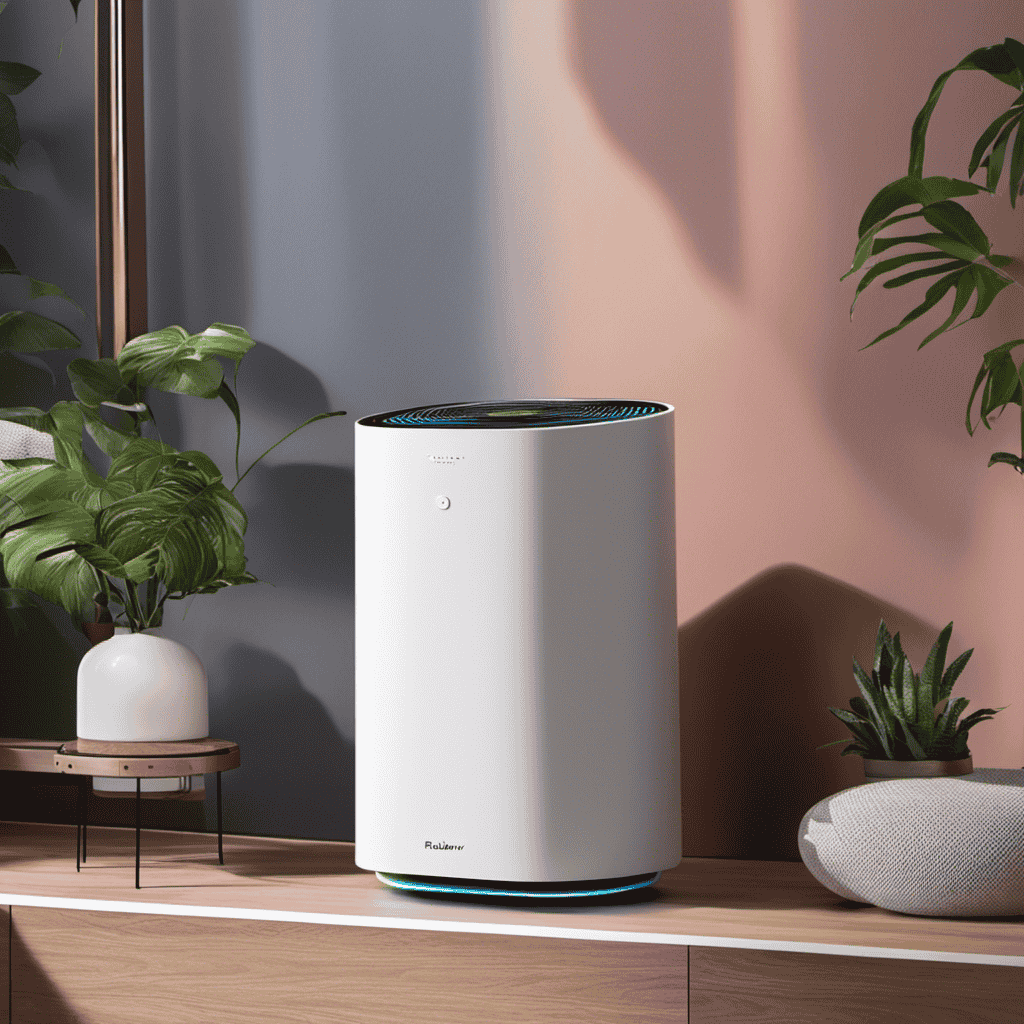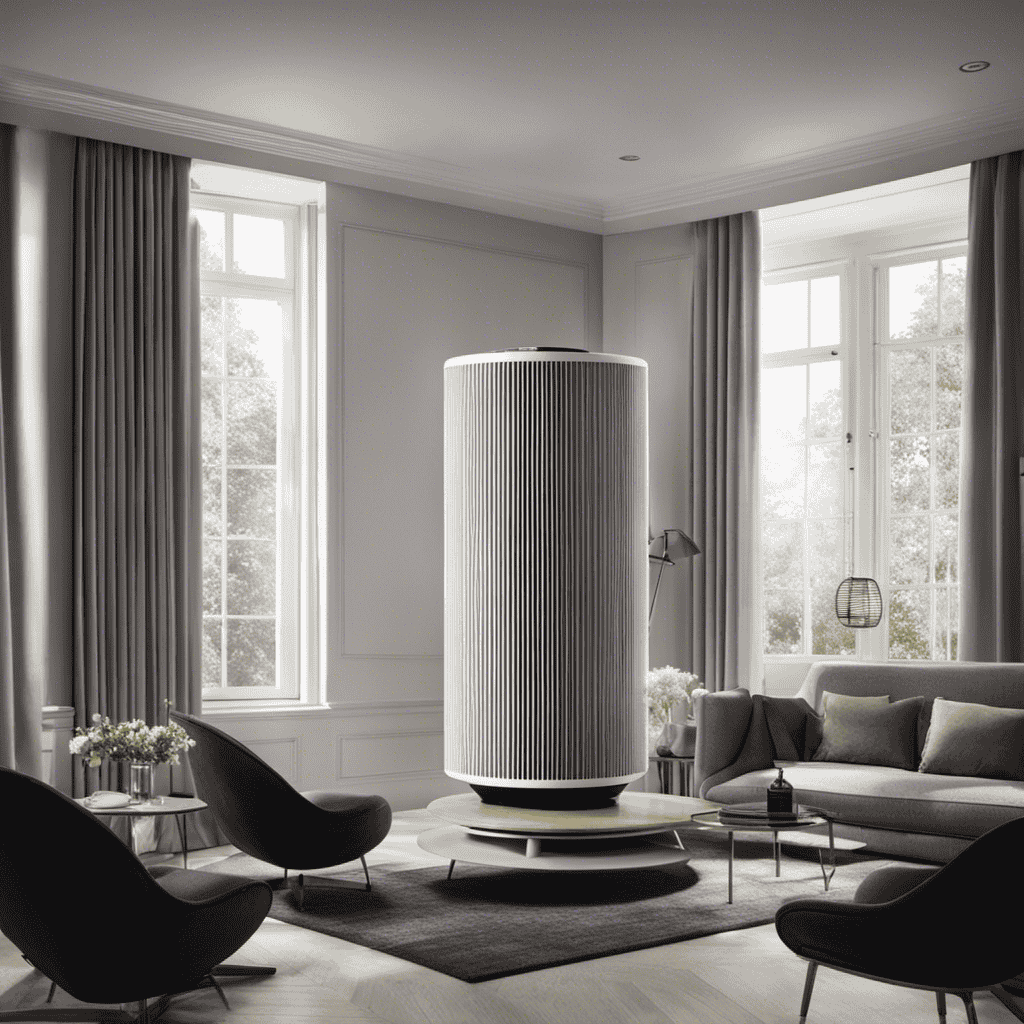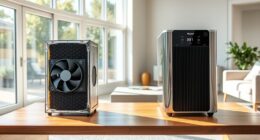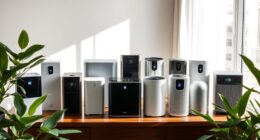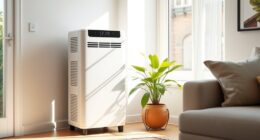When it comes to improving the air quality indoors, an air purifier can make a significant difference. This effective tool removes harmful pollutants, guaranteeing that the air we inhale is pure and refreshing.
With its advanced technology, an air purifier effectively eliminates common indoor pollutants, such as dust, pollen, pet dander, and even harmful chemicals. Not only does it improve indoor air quality, but it also brings a myriad of benefits, including asthma relief, better sleep, improved productivity, and a healthier home environment overall.
Key Takeaways
- An air purifier is used to improve indoor air quality.
- It provides asthma relief and alleviates allergy symptoms.
- It enhances sleep quality and boosts productivity.
- It creates a healthier home environment by reducing levels of allergens and improving overall air quality.
Benefits of Using an Air Purifier
Using an air purifier can greatly improve the quality of the air I breathe in my home. Air purifiers are specifically designed to remove allergens and dust particles from the air, making it cleaner and healthier to breathe.
For allergy prevention, air purifiers are equipped with HEPA filters that can capture and trap tiny allergen particles such as pollen, pet dander, and dust mites. These filters can effectively reduce the presence of these allergens in the air, providing relief for allergy sufferers.
Additionally, air purifiers are also effective at removing dust from the air. The filters in air purifiers can capture dust particles, preventing them from settling on surfaces and reducing the amount of dust that can be inhaled.
Overall, using an air purifier can significantly improve indoor air quality by preventing allergies and reducing dust particles.
How an Air Purifier Works
When it comes to understanding how an air purifier works, it’s important to delve into its air filtration process, particle removal mechanism, and purification technology.
The air filtration process involves the removal of pollutants and contaminants from the air, ensuring cleaner and healthier indoor air quality.
The particle removal mechanism utilizes various filters to trap and eliminate particles, such as dust, pollen, pet dander, and bacteria, from the air.
Additionally, the purification technology employed in air purifiers can include activated carbon filters, UV-C light, and ionizers. These components work together to effectively purify the air by neutralizing odors, killing germs, and reducing allergens.
Air Filtration Process
To effectively purify the air in your home, you’ll want to understand the air filtration process. It is crucial to maintain your air purifier regularly to ensure its optimal performance. Here are some important points to consider:
- Regular Filter Replacement: Replace the filters according to the manufacturer’s instructions to maintain the purification efficiency.
- Cleaning the Unit: Regularly clean the exterior and interior of the air purifier to remove dust and debris that can hinder its performance.
- Inspecting the Pre-filter: Check the pre-filter regularly and clean or replace it if necessary. This helps prolong the life of the main filter.
- Cost Comparison: Compare the cost of different air purifiers, taking into account the initial purchase cost, filter replacement cost, and energy consumption.
Particle Removal Mechanism
Understanding the particle removal mechanism will help you ensure that your air is effectively purified in your home. When it comes to indoor air pollution, having a well-functioning air purifier is essential.
The particle removal mechanism is a crucial aspect of air purifier maintenance. This mechanism involves the use of filters that trap and remove various particles from the air. The primary filter used in most air purifiers is the High-Efficiency Particulate Air (HEPA) filter. This filter is capable of capturing tiny particles as small as 0.3 microns in size, including dust, pollen, pet dander, and mold spores.
Regularly cleaning or replacing the filters is necessary to maintain the efficiency of the particle removal mechanism. By understanding this mechanism and performing regular maintenance, you can ensure that your air purifier continues to effectively remove particles and improve the air quality in your home.
Purification Technology Explained
The HEPA filter is capable of capturing tiny particles as small as 0.3 microns in size, such as dust, pollen, pet dander, and mold spores. This advanced technology is essential for maintaining clean and healthy indoor air.
Here are some key benefits of using HEPA filters in air purifiers:
-
Efficient particle removal: HEPA filters are designed to trap even the smallest airborne particles, ensuring that the air you breathe is free from contaminants.
-
Allergy relief: By capturing allergens like dust and pollen, HEPA filters can help alleviate symptoms for allergy sufferers, providing much-needed relief.
-
Improved respiratory health: HEPA filters remove harmful particles that can irritate the respiratory system, promoting better lung health.
-
Reduced indoor pollution: HEPA filters play a crucial role in reducing indoor pollution, making your living space cleaner and safer.
To ensure optimal performance, regular air purifier maintenance is necessary. This includes cleaning or replacing the HEPA filter as recommended by the manufacturer to maintain the effectiveness of your air purifier.
Types of Pollutants Removed by Air Purifiers
Air purifiers can effectively remove various types of pollutants from the air in your home, which can greatly benefit your respiratory health and help alleviate symptoms of seasonal allergies. These devices work by using different types of filters and technologies to capture and remove particles, allergens, and toxins from the air.
For example, HEPA filters are highly efficient at trapping tiny particles like dust, pollen, pet dander, and mold spores, which are common triggers for allergies. Additionally, activated carbon filters can effectively remove odors, gases, and chemical pollutants from the air.
By eliminating these pollutants, air purifiers create a cleaner and healthier environment for you and your family.
Now, let’s explore some of the most common indoor air pollutants that air purifiers can help eliminate.
Common Indoor Air Pollutants
Common indoor pollutants that can be effectively eliminated by air purifiers include dust, pollen, pet dander, mold spores, odors, gases, and chemical pollutants.
-
Dust: Air purifiers with high-efficiency particulate air (HEPA) filters can capture particles as small as 0.3 microns, effectively removing dust from the air.
-
Pollen: HEPA filters can also trap pollen particles, providing relief for individuals with allergies.
-
Pet dander: Air purifiers equipped with HEPA filters can successfully capture pet dander, reducing allergic reactions.
-
Mold spores: Air purifiers with HEPA filters and activated carbon filters help prevent the growth and spread of mold by capturing and neutralizing mold spores in the air.
Air purifiers serve as effective tools for mold and mildew prevention by removing common indoor air pollutants. By utilizing HEPA filters and activated carbon filters, air purifiers can improve indoor air quality and create a healthier living environment.
Health Effects of Poor Indoor Air Quality
Using air purifiers can greatly reduce the health effects of poor indoor air quality, such as allergies and respiratory issues. Air purifiers work by filtering out airborne particles and pollutants, improving the overall air quality in a room.
When it comes to allergies, air purifiers are particularly effective in removing common allergens such as dust mites, pollen, pet dander, and mold spores from the air. By reducing the levels of these allergens, air purifiers can help alleviate allergy symptoms and provide relief to individuals suffering from allergies.
Additionally, air purifiers can also improve respiratory health by removing harmful particles, such as smoke, volatile organic compounds (VOCs), and other pollutants that can irritate the respiratory system.
Overall, air purifiers play a crucial role in creating a healthier indoor environment.
In the subsequent section, we will further explore the specific types of allergens that air purifiers can effectively remove.
Allergens and Air Purifiers
When it comes to allergies, air purifiers are particularly effective in reducing levels of dust mites, pollen, pet dander, and mold spores in the air. These tiny particles can trigger allergic reactions and worsen respiratory conditions.
To effectively control allergens and maintain the performance of your air purifier, it is essential to follow proper maintenance guidelines. Here are some key steps to consider:
- Regularly clean or replace the air filters to ensure optimal filtration efficiency.
- Keep the surrounding area clean to prevent the accumulation of dust and other allergens.
- Monitor the air purifier’s performance and check for any signs of malfunction.
- Schedule professional maintenance and servicing periodically to ensure the longevity and effectiveness of your air purifier.
Air Purifiers for Pet Owners
If you’re a pet owner, it’s important to consider an air purifier specifically designed to tackle pet-related allergens. Pet dander control is crucial for those with allergies or asthma, as pet dander contains proteins that can trigger allergic reactions. Fortunately, there are air purifiers on the market that are specifically designed to address these concerns. These air purifiers typically feature a combination of filters, including a HEPA filter, to effectively capture pet dander and other allergens. Additionally, some models may incorporate additional features such as activated carbon filters to remove odors associated with pets. To help you make an informed decision, here is a comparison of four popular air purifiers for pet allergies:
| Air Purifier | Features | Coverage Area | Price |
|---|---|---|---|
| Model A | HEPA filter, activated carbon filter, pet-specific design | 500 sq ft | $200 |
| Model B | HEPA filter, antimicrobial treatment, customizable settings | 700 sq ft | $250 |
| Model C | HEPA filter, ozone-free operation, quiet mode | 350 sq ft | $150 |
| Model D | HEPA filter, pet allergy friendly certification, smart features | 1000 sq ft | $300 |
With these options, you can find an air purifier that suits your specific needs and budget, ensuring a healthier environment for both you and your furry friend.
Air Purifiers for Smokers
When it comes to air purifiers for smokers, there are a few key points to consider.
First, smoke elimination techniques are crucial in effectively removing smoke particles from the air. This can be achieved through the use of HEPA filters, which are designed to capture even the smallest smoke particles.
Additionally, odor reduction methods are important in eliminating the strong smell associated with smoking. Activated carbon filters are commonly used in air purifiers to absorb and neutralize odors, leaving the air smelling fresh and clean.
Lastly, the health benefits of using air purifiers for smokers cannot be overlooked. By removing smoke particles and reducing odors, air purifiers can significantly improve indoor air quality, reducing the risk of respiratory issues and other health problems associated with secondhand smoke exposure.
Smoke Elimination Techniques
One effective way to get rid of smoke in a room is by using an air purifier. An air purifier can effectively remove smoke particles and improve indoor air quality.
Here are some smoke elimination techniques that an air purifier can provide:
-
High-Efficiency Particulate Air (HEPA) Filter: An air purifier equipped with a HEPA filter can capture smoke particles as small as 0.3 microns, effectively removing them from the air.
-
Activated Carbon Filter: This type of filter can absorb smoke odors and harmful volatile organic compounds (VOCs), leaving the air fresh and clean.
-
Ionization: Some air purifiers use ionization technology to charge smoke particles, making them stick to surfaces or get trapped in a filter.
-
UV-C Light: Air purifiers with UV-C light can kill bacteria and viruses present in smoke, ensuring a healthier environment.
Indoor air pollution sources, such as cigarette smoke, cooking fumes, and wildfires, can be effectively addressed by using an air purifier with these advanced smoke elimination techniques.
Odor Reduction Methods
To reduce odors in your home, try using activated carbon filters. They can effectively absorb and eliminate unpleasant smells. Activated carbon, also known as activated charcoal, is a highly porous substance. It has the ability to trap and remove various odor-causing compounds from the air. These filters work by attracting and adsorbing the odor molecules onto their porous surface, thereby neutralizing the smell.
In addition to activated carbon filters, there are also other odor elimination techniques that can be used. One such method is the use of natural air fresheners. These air fresheners are made from organic materials such as essential oils, herbs, and spices. They help to mask and eliminate odors without the use of harsh chemicals or artificial fragrances. This makes them a safer and more eco-friendly option for odor control in your home.
Health Benefits Explained
If you’re looking to improve your overall well-being, activated carbon filters can help by reducing unpleasant odors in your home. But did you know that these filters also offer a range of health benefits?
Thanks to advancements in air purification technology, allergen control has become more effective than ever before. Here are some key ways that activated carbon filters can improve your health:
-
Removal of allergens: Activated carbon filters can trap and eliminate common allergens such as pollen, dust mites, and pet dander, providing relief for those with allergies or asthma.
-
Reduction of volatile organic compounds (VOCs): VOCs are harmful chemicals often found in household products and can cause various health issues. Activated carbon filters can effectively remove these pollutants from the air.
-
Odor elimination: Along with reducing unpleasant smells, activated carbon filters can eliminate harmful gases and chemicals that contribute to indoor air pollution.
-
Improved respiratory health: By removing allergens and pollutants from the air, activated carbon filters can help maintain healthy respiratory function and reduce the risk of respiratory diseases.
With these advancements in air purification technology, activated carbon filters have become an essential tool in promoting a healthier living environment.
Air Purifiers for People With Respiratory Conditions
Having respiratory conditions, you’ll find that an air purifier can greatly improve your indoor air quality. Air purifiers are designed to remove pollutants and allergens from the air, making it easier for you to breathe.
The effectiveness of an air purifier depends on several factors, including the size of the room, the type of pollutants present, and the specific model of the purifier.
To ensure the optimal performance of your air purifier, regular maintenance is necessary. This includes changing the filters as recommended by the manufacturer, cleaning the purifier regularly, and keeping the surrounding area clean and dust-free.
Air Purifiers for Odor Elimination
When it comes to air purifiers, one of the key benefits is their ability to eliminate unpleasant smells. Whether it’s the lingering odor of cooking, pet dander, or tobacco smoke, a good air purifier can effectively remove these odors and improve indoor air quality.
In addition to eliminating unpleasant smells, air purifiers also play a crucial role in removing harmful odors, such as volatile organic compounds (VOCs) and other pollutants, which can have detrimental effects on our health.
Eliminating Unpleasant Smells
You can use an air purifier to get rid of any unpleasant smells in your home. Air purifiers are designed to remove household odors and eliminate cooking smells, ensuring that your living space is fresh and clean.
Here are some key ways in which an air purifier can help:
-
Advanced Filtration: Air purifiers use high-quality filters to capture and trap odor-causing particles, such as smoke, pet dander, and cooking fumes.
-
Activated Carbon Technology: Many air purifiers feature activated carbon filters that effectively absorb and neutralize odors, leaving the air smelling fresh.
-
Ozone-Free Operation: Look for air purifiers that are ozone-free, as ozone can produce an unpleasant smell and is not recommended for indoor use.
-
Multiple Speed Settings: Some air purifiers offer adjustable speed settings, allowing you to customize the airflow and filtration based on your specific needs.
Improving Indoor Air Quality
To improve indoor air quality, it’s important to regularly clean your home and remove dust and allergens from surfaces. However, sometimes these measures alone may not be enough to combat allergies and asthma symptoms.
That’s where air purifiers come in. Air purifiers are devices designed to remove airborne contaminants from the air, including dust, pollen, pet dander, and mold spores. They work by using filters or other technologies to trap and capture these particles, preventing them from circulating in the air.
For reducing allergies, air purifiers with HEPA filters are recommended. HEPA filters can capture particles as small as 0.3 microns, effectively removing allergens from the air. Similarly, air purifiers with activated carbon filters can help reduce asthma symptoms by trapping volatile organic compounds (VOCs) and other irritants.
Removing Harmful Odors
When it comes to maintaining a fresh and clean indoor environment, air purifiers can be incredibly effective. Not only do they remove harmful particles from the air, but they are also capable of eliminating unpleasant odors that can linger in our homes.
Whether it’s the pungent smell of last night’s dinner or the lingering scent of our furry friends, air purifiers can help us breathe easier by removing kitchen odors and eliminating pet smells.
Here are some key ways in which air purifiers achieve this:
-
Activated carbon filters: These filters are designed to trap and neutralize odorous particles, effectively eliminating kitchen odors and pet smells.
-
Ionizers: By releasing negative ions, ionizers can help break down and neutralize odor-causing molecules, leaving the air fresh and odor-free.
-
UV-C light: This technology is capable of destroying bacteria and viruses that can cause unpleasant smells, ensuring a clean and fresh environment.
-
Ozone generators: While controversial, ozone generators can be effective in removing strong odors by neutralizing them at a molecular level.
With the right air purifier, we can enjoy a clean and odor-free home environment.
Air Purifiers for Mold and Mildew Prevention
Air purifiers can help reduce mold and mildew by filtering out airborne spores. These microscopic particles can cause allergies and respiratory issues, so it’s crucial to have an effective air purification system in place.
Air purifiers designed for allergy prevention utilize HEPA filters, which can capture particles as small as 0.3 microns. These filters are highly efficient in trapping mold spores and preventing them from circulating in the air.
Additionally, air purifiers with UV-C technology can destroy the DNA of mold and mildew, preventing them from reproducing. This ensures a healthier indoor environment, especially for individuals with allergies or asthma.
Moreover, air purifiers also play a vital role in virus protection. They can capture and eliminate airborne viruses, reducing the risk of airborne transmission.
Investing in a quality air purifier is a proactive step towards maintaining a clean and healthy living space.
Air Purifiers for Asthma Relief
As someone who suffers from asthma, I understand the importance of finding effective ways to reduce symptoms and improve indoor air quality.
Air purifiers have been extensively studied and proven to be beneficial for asthma relief. They work by filtering out allergens and irritants from the air, resulting in cleaner indoor air and a significant reduction in asthma symptoms.
Additionally, air purifiers are known for their high allergen removal efficiency, making them an essential tool for individuals with asthma who want to create a healthier living environment.
Asthma Symptom Reduction
Using an air purifier can help reduce asthma symptoms. Asthma prevention is crucial for individuals with this respiratory condition, and improving air quality is a key component of managing symptoms. Here are four reasons why an air purifier is an effective tool for asthma symptom reduction:
-
Filtration: Air purifiers can capture and remove airborne triggers such as dust mites, pet dander, pollen, and mold spores from the air, reducing exposure to these allergens.
-
Cleaner Indoor Air: By removing pollutants and irritants from the air, air purifiers help create a cleaner indoor environment, minimizing potential triggers for asthma attacks.
-
Improved Respiratory Health: Breathing in cleaner air can lead to improved respiratory health, reducing the severity and frequency of asthma symptoms.
-
Sleep Quality: Air purifiers can help improve sleep quality for asthma sufferers by reducing nighttime asthma symptoms and providing a more comfortable breathing environment.
Investing in an air purifier is a practical and effective way to improve indoor air quality, reduce asthma triggers, and ultimately alleviate asthma symptoms.
Cleaner Indoor Air
Invest in an air purifier to create a healthier environment indoors, helping to minimize potential triggers for asthma attacks. Air purifiers are highly beneficial for individuals suffering from allergies and those looking to reduce dust in their homes. These devices work by filtering out airborne particles, such as dust, pollen, pet dander, and mold spores, improving the overall air quality. By removing these allergens, air purifiers can alleviate allergy symptoms and provide relief. Moreover, air purifiers are effective in reducing dust in the indoor environment, making it easier to maintain a clean and dust-free living space.
To better understand the benefits of air purifiers for allergies and dust reduction, refer to the table below:
| Air Purifier Benefits | Explanation |
|---|---|
| Allergy Relief | Air purifiers capture and eliminate allergens, such as pollen and pet dander, reducing allergic reactions. |
| Dust Reduction | By trapping dust particles, air purifiers help to minimize dust accumulation in the environment, leading to cleaner indoor air. |
| Improved Air Quality | Air purifiers remove harmful pollutants, improving the overall air quality and promoting better respiratory health. |
Investing in an air purifier can greatly improve indoor air quality, making it an essential tool for those with allergies and dust sensitivities.
Allergen Removal Efficiency
To effectively reduce allergens in your home, ensure that the air purifier you choose has a high allergen removal efficiency. A high allergen removal efficiency means that the air purifier is capable of filtering out a large percentage of allergens from the air, resulting in improved indoor air quality.
Here are four key reasons why allergen removal efficiency is crucial for air purifiers:
-
Effective allergen filtration: A high allergen removal efficiency ensures that common allergens such as pollen, dust mites, pet dander, and mold spores are effectively captured and removed from the air.
-
Reduced allergy symptoms: By removing allergens from the air, air purifiers with high allergen removal efficiency can help reduce allergy symptoms such as sneezing, coughing, and itching.
-
Cleaner breathing environment: With improved allergen filtration, the air in your home becomes cleaner, providing a healthier breathing environment for you and your family.
-
Enhanced overall air quality: By removing allergens, air purifiers contribute to overall air quality improvement, reducing the risk of respiratory illnesses and improving general well-being.
Choosing an air purifier with high allergen removal efficiency is a smart investment for anyone looking to improve their indoor air quality and reduce allergen-related health issues.
Air Purifiers for Better Sleep
Having an air purifier in your bedroom can help improve your sleep quality. Air purifiers are highly effective in removing allergens such as dust mites, pollen, pet dander, and mold spores from the air. These allergens can trigger allergies and respiratory issues, leading to discomfort and disturbed sleep.
By filtering out these allergens, air purifiers create a cleaner and healthier environment for breathing, promoting better sleep. Air purifiers for allergies are specifically designed with HEPA (High-Efficiency Particulate Air) filters that can capture particles as small as 0.3 microns. This ensures that the air you breathe is free from common allergens, allowing you to breathe easier and sleep more soundly.
Air Purifiers for Improved Productivity
Air purifiers can increase productivity by creating a cleaner and healthier working environment. They are particularly beneficial in office spaces where air quality can be compromised by various factors.
Here are some key reasons why air purifiers are essential for improving productivity:
-
Removes allergens: Air purifiers effectively filter out allergens such as pollen, dust mites, and pet dander, reducing the risk of allergies and respiratory issues for allergy sufferers.
-
Eliminates pollutants: These devices remove harmful particles like smoke, bacteria, and volatile organic compounds (VOCs) from the air, ensuring a healthier workspace.
-
Reduces odors: Air purifiers with activated carbon filters help eliminate unpleasant odors, creating a more pleasant and refreshing environment.
-
Enhances focus and concentration: By providing clean and fresh air, air purifiers can help employees stay alert, focused, and productive throughout the day.
Investing in air purifiers for office spaces is a smart move to create a healthier and more productive working environment, especially for allergy sufferers.
Air Purifiers for a Healthier Home Environment
Invest in an air purifier for your home to create a healthier environment for you and your family. Air purifiers are highly effective in relieving allergies and removing dust from the air.
These devices work by filtering out airborne allergens such as pollen, pet dander, and dust mites. The filters in air purifiers capture these particles, preventing them from circulating in your home and triggering allergic reactions.
Additionally, air purifiers are equipped with HEPA filters, which are specially designed to remove even the tiniest dust particles from the air. Dust can contain various harmful substances, such as bacteria, viruses, and mold spores. By removing dust particles, air purifiers help improve indoor air quality and reduce the risk of respiratory issues.
Investing in an air purifier is a smart choice for maintaining a healthier home environment.
What Are the Benefits of Using an Air Purifier?
Breathing cleaner air can have significant health benefits, and an air purifier can help achieve that. Many air purifier benefits include removing harmful particles like dust, pollen, and pet dander from the air, reducing allergy symptoms, eliminating unpleasant odors, and improving overall air quality in your home or office.
Frequently Asked Questions
Can an Air Purifier Completely Eliminate All Indoor Air Pollutants?
No, an air purifier cannot completely eliminate all indoor air pollutants. While it is effective in reducing pollutants, it is important to understand its limitations. The benefits of using an air purifier include improved air quality and reduction in respiratory issues.
How Often Should the Filters in an Air Purifier Be Replaced?
Filter replacement frequency is crucial for optimal air purifier performance. Signs of a dirty filter include reduced airflow and a noticeable decrease in air quality. Regular filter changes ensure cleaner air and a healthier environment.
Can an Air Purifier Help With Allergies Caused by Outdoor Pollutants?
Yes, an air purifier can help with allergies caused by outdoor pollutants. By filtering out airborne allergens and improving outdoor air quality, it can reduce exposure to allergens and improve respiratory health.
Are Air Purifiers Noisy and Can They Disrupt Sleep?
Air purifiers vary in noise levels, but most models have settings that can be adjusted for quieter operation during sleep. When selecting an air purifier, consider its noise level and effectiveness in removing airborne pollutants.
Are There Any Potential Side Effects or Risks Associated With Using an Air Purifier?
Using an air purifier can have potential health risks. However, it’s important to note that the effectiveness of air purifiers in reducing indoor air pollutants outweighs these risks.
Conclusion
In conclusion, an air purifier is a valuable tool for improving indoor air quality and promoting a healthier home environment. By removing common pollutants such as dust, pollen, pet dander, and mold spores, air purifiers can help alleviate allergies, asthma symptoms, and promote better sleep.
In fact, studies have shown that using an air purifier can reduce the number of asthma exacerbations by up to 71%. Just like a shield protecting a knight from arrows, an air purifier acts as a shield against harmful airborne particles, ensuring cleaner and safer air for you and your loved ones.

